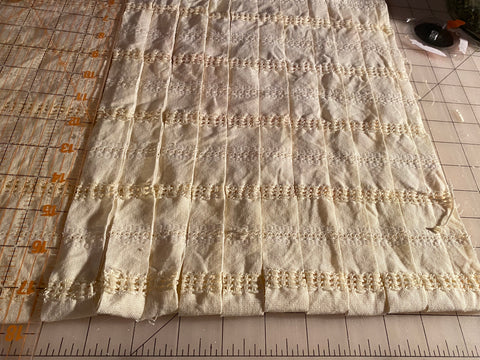My First Wedding Dress Build, Summer 2020
I woke up this morning inspired to finally write on the wedding dress build I did this spring and summer for a dear friend of mine. I've known that I've wanted to try sharing more of my process in this format, because not all social media platforms are equally equipped at exploring the depths of things.
Emily came to me about making a dress for her wedding day. She already had one dress- an heirloom silk gown from the 1930s- worn by not one, but two women of different generations of family who had come before. And let me tell you, it was TINY, like so many vintage garments are. (We are a growing species >> Seamstresses know.) So the plan was to cut it up and start over with the hallowed fiber of familial wedding festivities past. We collaboratively cooked up a two-piece top and skirt concept and pattern pieces were made.
We decided to create a new textile for the bodice. Tests were done, with additional materials ranging from hemp sliver, to lace, to birch bark, to cattails- until the ideal materials were selected to be woven into the matrix.

and once selected, all materials where cut into strips. All of the fiber from the original dress made it into the new one. including the tricky bodice cuts,

and additional vintage lace that I had been given by an older seamstress who had decided to pass on her stock. No materials were actually purchased new for this whole project- except thread.

And soon the weaving was underway. My choice of loom was a 3x3 ft frame loom constructed by my friend in the woodshop under the house,

which I warped with some of my handspun hemp yarn. It was my first time using my own handspun as a warp- which is risky business because a warp must be the strongest part of a weaving. It is the internal lattice system on which the tension of everything relies, but I put the project's fate in the hands of the hemp goddex, who is famous for her strength under tension.

Bundles of fabric- turned-yarn, or 'butterflies' as they are called, wound their way between the warp end threads at my hands.

until a most textured precious textile materialized..

Many nights were spent right here

and here

and ever still here. But with Ronan's company.

Until it was time to come off the loom! >> a feeling that I live for. I actually made two entire textiles this way, after deciding to add some extra detail in the skirt, but more of that to come.

Equally as 'invigorating' as pulling a textile off a loom, is the moment when it is cut into pattern pieces >> with a constant loop of prayers in mind that reassure everything will withstand the incisions.

And eventually, it was possible to breathe again.

I had fun playing bride at this stage!

The making of the skirt followed suit. Silky swaths of the 1930s dress were kept in tact for creating the tiers of liquid light lusciousness that became. I mentioned that I made an entire second woven textile, that became one tier of the skirt and added shimmering detail to the bottom.

And then there was a dress. True to our vision, and so Emily.

Our first fitting was tear-inducing. It fit Emily just so.

After the fitting, all that was left was to put the finishings on. The top and skirt each buttoned completely down the back with iridescent seashell buttons

On the wedding day, Emily and her partner Tom decided to have a much smaller family gathering than originally planned due to Covid. They have postponed the celebrations for a date in the future, but I wanted to do something to sanctify the date that consecrated their marriage, just for them.

So I embroidered this piece of plant dyed hemp cloth with the date and sewed it to the inside of her top, right on her heart, as a surprise.

(Photo by Linnaea Meyer)
I could not have asked for a smoother process in everything that materialized to bring this dress together for this fairy queen bride. I am so thankful for her trust in me with this sacred act. I think this is the kind of storying that makes a garment special, for a holy moment or a sacred ceremony. One might even say it was meant to be.